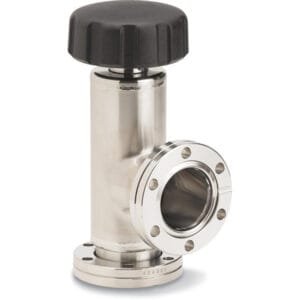ConFlat (CF) UHV Reducer Tees: A Comprehensive Overview
ConFlat (CF) UHV Reducer Tees are essential components in the design and operation of ultra-high vacuum (UHV) systems. These specially designed tees allow for seamless transitions between different pipe or tube sizes while maintaining the integrity of the vacuum. Fabricated from 304L stainless steel and sealed with ConFlat (CF) knife-edge flanges, these reducer tees ensure reliable, leak-tight connections under the stringent conditions of ultra-high vacuum environments. TFM’s ConFlat (CF) UHV Reducer Tees are precision-engineered to meet the needs of industries such as semiconductor manufacturing, research, and space simulation, where maintaining the highest standards of vacuum performance is critical.
What are ConFlat (CF) UHV Reducer Tees?
ConFlat (CF) UHV Reducer Tees are vacuum fittings that enable multiple connections at varying flange sizes, providing a crucial role in UHV systems. The “tee” configuration typically has one larger port and one or two smaller ports, allowing for efficient routing and size adaptation of various vacuum components. The reducer aspect refers to the transition from a larger diameter to a smaller one, providing a seamless connection between different components such as pumps, gauges, and feedthroughs.
Constructed with 304L stainless steel, these tees are highly resistant to corrosion, ensuring that they maintain the vacuum integrity of the system even under extreme conditions. The ConFlat (CF) flange design ensures that these tees provide leak-tight, reliable seals, making them the ideal choice for critical vacuum applications.
Key Features of ConFlat (CF) UHV Reducer Tees
1. Premium 304L Stainless Steel Construction
Our ConFlat (CF) UHV Reducer Tees are made from 304L stainless steel, known for its high resistance to corrosion and excellent performance in vacuum applications. This material ensures a long lifespan and minimizes outgassing, which is essential for maintaining vacuum stability over time.
2. Knife-Edge ConFlat Flanges
The hallmark of the ConFlat (CF) design is the knife-edge flange, which creates a perfect, leak-tight seal when paired with a compatible gasket. This ensures that the UHV reducer tees maintain the integrity of the vacuum and prevent any unwanted gas leakage.
3. Versatile Reducer Configuration
These tees come in various configurations, providing a smooth transition between different flange sizes. This versatility makes them essential for adapting to different system setups and vacuum requirements, whether in laboratory research or industrial processes.
4. Vibration-Resistant, Through-Hole Bolt Holes
CF UHV Reducer Tees are designed with through-hole bolt flanges, ensuring that they remain securely fixed within the vacuum system. This feature helps to prevent any movement or loosening of connections, even in environments subject to vibrations or thermal expansion.
5. Modular and Customizable Design
TFM’s ConFlat (CF) UHV Reducer Tees are designed for easy integration into any UHV system. With customizable port sizes, threaded sides, and additional features like rotatable flanges, they offer flexibility for a wide variety of configurations.
Applications of ConFlat (CF) UHV Reducer Tees
ConFlat (CF) UHV Reducer Tees play a critical role in several industries where precise vacuum control is essential. Some common applications include:
Semiconductor Manufacturing: In semiconductor fabrication, where precise control over the vacuum is necessary for deposition, etching, and other processes, CF UHV Reducer Tees help integrate different components and maintain a stable environment.
Space Simulation: These tees are used in vacuum chambers that simulate space conditions for testing satellites, components, and scientific instruments before they are launched into space.
Material Science and Surface Research: In research labs, CF reducer tees are used to connect various vacuum components and ensure clean, controlled environments for material testing and surface science experiments.
Accelerators and Particle Physics: High-energy particle accelerators require precision vacuum systems for maintaining particle beam integrity. CF UHV Reducer Tees are ideal for connecting large and small vacuum tubes in these systems.
Why Choose TFM’s ConFlat (CF) UHV Reducer Tees?
At TFM, we specialize in delivering high-quality ConFlat (CF) UHV Reducer Tees that meet the demanding standards of UHV applications. Our products are:
Durable and Reliable: Crafted from 304L stainless steel, ensuring long-lasting performance in UHV environments.
Precision-engineered: Each component is designed to offer the highest level of compatibility and leak-tight performance.
Customizable: We offer tailored solutions to meet your specific vacuum system requirements, from flange size to port configuration.
Tested for Quality: Every CF UHV Reducer Tee is rigorously tested to ensure it meets our high standards for vacuum integrity and durability.
Ordering Table
| Flange Size/OD (Large) | Flange Size/OD (Small) | Part Number |
| DN16CF (1.33" OD) | DN16CF (1.33" OD) | T-0275-133 |
| DN25CF (2.13" OD) | DN25CF (2.13" OD) | T-0275-212 |
| DN16CF (1.33" OD) | DN16CF (1.33" OD) | T-0337-133 |
| DN35CF-DN40CF (2.75" OD) | DN35CF-DN40CF (2.75" OD) | T-0337-275 |
| DN35CF-DN40CF (2.75" OD) | DN35CF-DN40CF (2.75" OD) | T-0450-275 |
| DN50CF (3.38" OD) | DN50CF (3.38" OD) | T-0450-337 |
| DN50CF (3.38" OD) | DN50CF (3.38" OD) | T-0462-337 |
| DN63CF (4.50" OD) | DN63CF (4.50" OD) | T-0462-450 |
| DN35CF-DN40CF (2.75" OD) | DN35CF-DN40CF (2.75" OD) | T-0600-275 |
| DN50CF (3.38" OD) | DN50CF (3.38" OD) | T-0600-337 |
| DN63CF (4.50" OD) | DN63CF (4.50" OD) | T-0600-450 |
| DN75CF (4.63" OD) | DN75CF (4.63" OD) | T-0600-462 |
| DN100CF (6.00" OD) | DN100CF (6.00" OD) | T-0675-600 |
| DN35CF-DN40CF (2.75" OD) | DN35CF-DN40CF (2.75" OD) | T-0800-275 |
| DN50CF (3.38" OD) | DN50CF (3.38" OD) | T-0800-337 |
| DN63CF (4.50" OD) | DN63CF (4.50" OD) | T-0800-450 |
| DN100CF (6.00" OD) | DN100CF (6.00" OD) | T-0800-600 |
| DN160CF (8.00" OD) | DN160CF (8.00" OD) | T-1000-800 |





Reviews
There are no reviews yet.